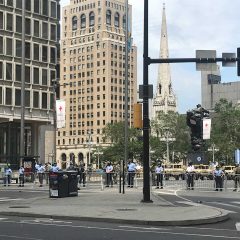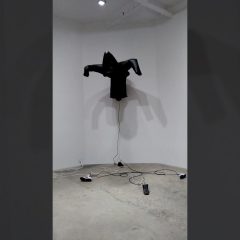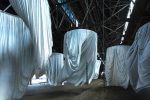This week’s Weekly has my quick reviews of Paul Chan at the Fabric Workshop and Museum and Vera Lutter, Abelardo Morrel and Ann Hamilton at the Print Center. Here’s the link to the art page and below is the copy with more pictures.
Seeing the Light
The slow art movement gives viewers a quietly affirming outlook on life.
At a time when we work too much, watch too much TV and never get enough sleep, some artists are asking us to slow down. Paul Chan at the Fabric Workshop and Museum and Ann Hamilton, Vera Lutter and Abelardo Morell at the Print Center make art so slow and lovely it’s like a tonic.
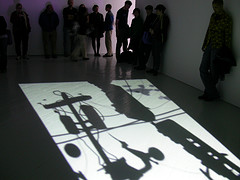
Paul Chan’s First Light installed at the Fabric Workshop and Museum.
Paul Chan’s two 14-minute animated projections 1st Light and 4th Light at the FWM are about falling, ascending and transcending. 1st Light (shown at the 2006 Whitney Biennial) is a projection on the floor, and as you look down, what moves before you are pieces of the known world unloosed from their moorings and seemingly moving up weightlessly. These objects—a bicycle wheel, a telephone pole, light poles, car parts, buildings, sunglasses—move silently in slow motion without colliding. It’s the rapture of consumer goods.
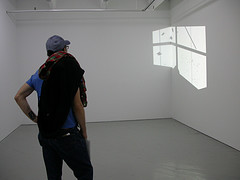
Fourth Light, a projection on the wall that looks more like a window than the reflecting pool that is First Light.
But there’s a counter-current at work as fast-streaking forms begin hurtling the other way. Humans drop like stones from the sky.
The work evokes 9/11, yet the piece is about much more. The rapture of trash/consumer goods and the downcasting of humans is backward, surely. And Chan’s point must be that we can and must do more to elevate life.
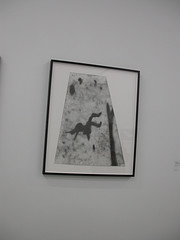
Charcoal drawing showing a body falling.
The artist, who’s also a committed activist with an international following, works from charcoal drawings which he then animates on the computer. Several drawings are on view along with the animations. Chan says he loves to draw, a slow process that allows him to think and create.
“When I’m drawing, it’s like I’m on vacation,” he says. “That’s the ride.” The rest is work, presumably—necessary but not as rewarding. Chan’s 4th Light (there will be seven in all) is a wall piece and a different kind of window than the floor piece. 4th Light evokes the daily domesticity of birds, bees and people, and is quietly affirming.
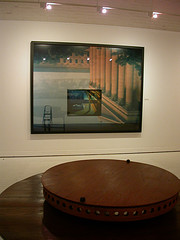
Abelardo Morell’s camera obscura photograph made at the Philadelphia Museum of Art and showing a Giorgio de Chirico painting on the wall.
The internationally renowned artists commissioned by the Print Center for “Taken With Time” came to Philadelphia to make site-specific projects using a camera obscura, photography’s oldest tool (a box with a hole in it that captures light and creates an upside-down image of what’s seen through the hole). Abelardo Morell created a room-sized camera obscura at the Philadelphia Museum of Art that captures the museum’s exterior on a gallery wall housing a painting by surrealist artist Giorgio de Chirico.
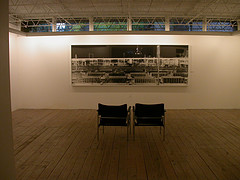
Vera Lutter’s x-ray-like photograph of the 30th St. Station rail yard.
Vera Lutter went to 30th Street Station and captured an X-ray-like image of the rail yard, and Ann Hamilton focused on people, creating ghostly images of congregations with a small pinhole camera.
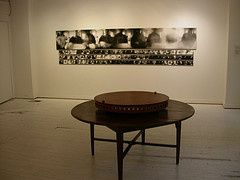
Ann Hamilton photograph from Independence Hall where she invited five groups of people to come in and recite together verses from the bible, the Declaration of Independence and the UN Declaration of Human Rights. The round lazy-susan on top of the table was turned into a pinhole camera to capture the people reciting.
In addition to the resulting photographs, there’s a video documenting the making of the works. These pieces are about Philadelphia, its history and its people, and they’re great civic contemplations. The artwork by these four artists is humanist and spiritual. It asks you to study life in the context of something greater. Make time for it.
“Taken With Time: A Camera Obscura Project With Ann Hamilton, Vera Lutter and Abelardo Morell”
Through Nov. 11. Print Center, 1614 Latimer St. 215.735.6090.
Paul Chan
Through Nov. 18. Fabric Workshop and Museum, 1315 Cherry St., fifth and sixth fls. 215.568.1111.


